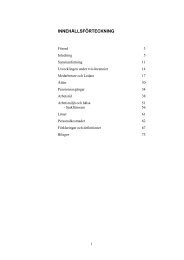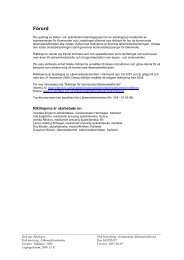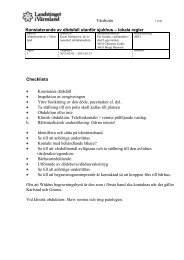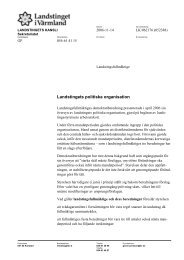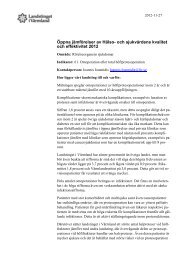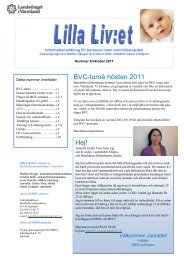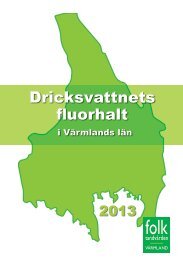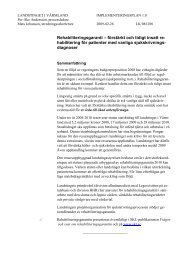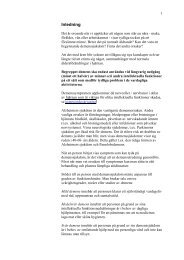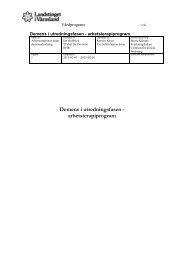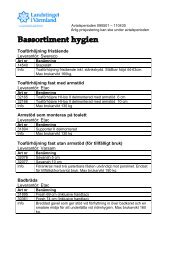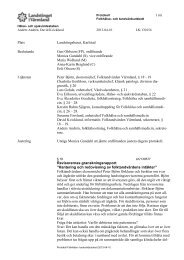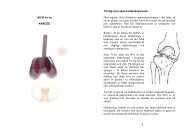Severs skada – paradigmskifte gällande diagnostik och behandling?
Severs skada – paradigmskifte gällande diagnostik och behandling?
Severs skada – paradigmskifte gällande diagnostik och behandling?
You also want an ePaper? Increase the reach of your titles
YUMPU automatically turns print PDFs into web optimized ePapers that Google loves.
Scand J Med Sci Sports 2011: 21: e42<strong>–</strong>e47<br />
doi: 10.1111/j.1600-0838.2010.01140.x<br />
Sever’s injury; treat it with a heel cup: a randomized, crossover study<br />
with two insole alternatives<br />
S. Perhamre 1{ , F. Lundin 2 , R. Norlin 3 , M. Kla¨ ssbo 2<br />
1 2 3<br />
Centre of Sports Medicine in Va¨rmland, Karlstad, Sweden, Centre for Clinical Research, Karlstad, Sweden, Department of<br />
Orthopaedics, University Hospital, O¨rebro University, O¨rebro, Sweden<br />
Corresponding author: Rolf Norlin MD, Department of Orthopaedic Surgery, University Hospital, 70185 O¨rebro, Sweden.<br />
Tel: 146 19 60 25 366, Fax: 146 19 60 25 337 E-mail: rolf.norlin@orebroll.se<br />
{<br />
Deceased.<br />
Accepted for publication 24 March 2010<br />
Sever’s injury (apophysitis calcanei) is considered to be the<br />
dominant cause of heel pain among children. Common<br />
advice is to reduce physical activity. However, our previous<br />
study showed that application of insoles reduced pain in<br />
Sever’s injury without having to reduce physical activity.<br />
The purpose of this study was to test which of the two<br />
insoles, the heel wedge or the heel cup, provided best pain<br />
relief during sport activity in boys with Sever’s injury<br />
(n 5 51). There was a crossover design in the first rando-<br />
Sever’s injury (apophysitis calcanei, Sever’s disease)<br />
is considered to be the dominant cause of heel pain<br />
among growing children between 8 and 15 years of<br />
age (Staheli, 1998; Ogden et al., 2004; Hendrix,<br />
2005). The heel complaint is benign, but includes a<br />
wide spectrum of pain intensity, and duration. It<br />
disappears without exception after puberty (Cyriax,<br />
1982; Brukner & Khan, 2007).<br />
Boys constitute two-thirds of the patients, probably<br />
due to different physical activity preferences<br />
compared with girls at the same age (Lutter, 1992).<br />
The physical activity that produces the highest levels<br />
of pain includes frequent running and jumping, and<br />
the sport that tends to dominate is soccer (Madden &<br />
Mellion, 1996). Outdoor winter sports are represented<br />
at a low frequency (Orava & Virtanen, 1982;<br />
Micheli & Ireland, 1987). The average age at onset is<br />
11<strong>–</strong>12 years (Lutter, 1992). In 35<strong>–</strong>40% of the cases,<br />
only one heel is affected (Micheli & Ireland, 1987;<br />
Perhamre et al., 2009)<br />
Sever’s injury is in modern literature described as<br />
induced by mechanical overuse with repetitive microtrauma<br />
to the calcaneal apophysis and its growth<br />
plate <strong>–</strong> the physis. The injury is reported to be related<br />
to forces from the Achilles tendon and calf complex<br />
due to shear stresses that compromise the apophysis<br />
(Peck, 1995; Volpon & de Carvalho Filho, 2002).<br />
Some authors suggest the repetitive impact forces at<br />
e42<br />
Bilaga 5<br />
& 2010 John Wiley & Sons A/S<br />
mized part of the study. In the second part, the boys, 9<strong>–</strong>14<br />
years, chose which insole they preferred. There was a<br />
reduction in odds score for pain to a fifth (a reduction of<br />
80%) for the cup compared with the wedge (Po0.001).<br />
When an active choice was made, the heel cup was preferred<br />
by 475% of the boys. All boys maintained their high level<br />
of physical activity throughout. At 1-year follow-up, 22 boys<br />
still used an insole and 19 of them reported its effect on pain<br />
as excellent or good (n 5 41).<br />
heel strike as an alternative or a complementary<br />
explanation (McKenzie et al., 1981; Orava & Virtanen,<br />
1982), including a microtraumatically induced<br />
calcaneal stress fracture of trabecular bone in refractory<br />
cases (Ogden et al., 2004).<br />
The clinical findings include tenderness over the<br />
lower part of the tubercle of calcanei and a positive<br />
calcaneal compression test, the squeeze test (Adams<br />
& Hamblen, 1990; Madden & Mellion, 1996; Kasser,<br />
2006).<br />
The traditional advice is to diminish or eliminate<br />
provoking activities for a prescribed period of time.<br />
This is similar to the recommendations for Mb<br />
Osgood Schlatter (Hendrix, 2005). The proposed<br />
treatment consists of a traditional concept for adults<br />
with Achilles tendon pain, most frequently including<br />
stretching, strengthening exercises for calf and extensor<br />
muscles, ice and NSAID treatment (Ishikawa,<br />
2005; Kasser, 2006). The importance of correcting<br />
malalignment, dominated by pronation, is stressed<br />
(Madden & Mellion, 1996) as well as the relation<br />
between pain and a tight heel cord (Szames et al.,<br />
1990). Insoles, either a molded plastizote orthosis to<br />
align pronation, or a heel wedge to directly reduce<br />
shear stresses to the apophysis, are the major insole<br />
proposals (Staheli, 1998; Kasser, 2006). Non-weightbearing<br />
with the lower limb immobilized in a short<br />
leg cast or a removable ankle orthosis worn during<br />
41



